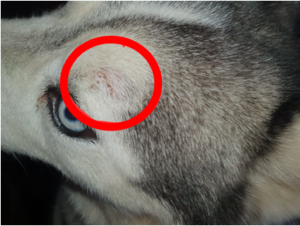Acute Moist Dermatitis (aka ‘Hot Spots’) can occur all year round, though more commonly throughout the warmer months. They are localized areas of inflammation and infection on the skin’s surface, which can be quite painful and itchy. They can develop and escalate quickly (often overnight).

Hot spots typically develop as a result of scratching or chewing, and common triggers include:
- Allergies to food or environment, like grasses, plants or cleaning products.
- Insect bites or stings.
- Flea infestations.
- Moisture trapped in the fur, especially in long-haired breeds.
- Excessive licking, scratching, or chewing due to irritation or boredom.
Symptoms may include:
- Red, inflamed, and painful skin.
- Oozing, pus-filled sores.
- Hair loss in the affected area.
- Constant licking, biting, or scratching of the area.
- A foul odour.
Treatment often includes:
- Clipping the fur around the affected area to allow for better air circulation and cleaning.
- Cleaning the hot spot with a mild antiseptic solution.
- Prescribing antibiotics to treat or prevent bacterial infection.
- Providing pain relief and anti-inflammatory medications.
- Identifying and addressing the underlying cause, such as allergies or fleas.
To prevent hot spots in your dog, consider the following:
- Regular grooming and keeping your dog’s coat clean and dry.
- Addressing any underlying allergies or skin conditions.
- Checking for fleas and ticks regularly and using appropriate preventatives.
- Avoiding over-bathing, as it can strip natural oils from their skin and lead to dryness and irritation.
- Providing mental stimulation and exercise to prevent excessive licking and scratching out of boredom.
If you suspect your dog has a hot spot, it’s essential to consult with a veterinarian for proper diagnosis and treatment. Left untreated, hot spots can worsen and become more painful for your pet, leading to complications and a longer recovery period.

